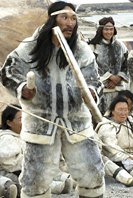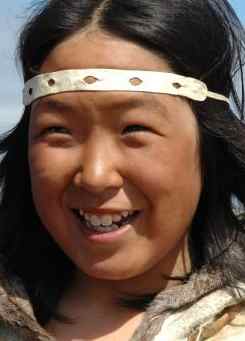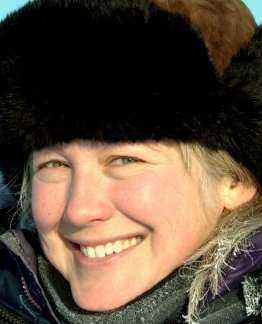Before
Tomorrow (Le Jour Avant Le Lendemain) played
at Montreal's 2008
Festival Nouveau Cinema. Miriam Cross, a film
reviewer at A'n'N
Vibe, gave the film 3 out of 4
stars. For more festival ratings, click
HERE.
 Storytelling
has always been a staple of Inuit culture, and the Canadian
feature film, Before Tomorrow, continues this tradition
by sharing a story of its own. Taking place circa 1840, Before
Tomorrow explores the ramifications of the European encounter
with a contented Inuit tribe. The film focuses on Ningiuq,
an elder woman of the tribe, who volunteers to help dry the
winter’s catch of fish on a remote island with her elderly
friend and grandson Maniq. As they wait anxiously for their
tribe to return, it gradually becomes clear that something
has gone wrong. With the winter season approaching, Ningiuq
must find the strength to protect her grandson and ensure
their survival in the wilderness.
Storytelling
has always been a staple of Inuit culture, and the Canadian
feature film, Before Tomorrow, continues this tradition
by sharing a story of its own. Taking place circa 1840, Before
Tomorrow explores the ramifications of the European encounter
with a contented Inuit tribe. The film focuses on Ningiuq,
an elder woman of the tribe, who volunteers to help dry the
winter’s catch of fish on a remote island with her elderly
friend and grandson Maniq. As they wait anxiously for their
tribe to return, it gradually becomes clear that something
has gone wrong. With the winter season approaching, Ningiuq
must find the strength to protect her grandson and ensure
their survival in the wilderness.
At its core, Before Tomorrow is about “The
power of storytelling, how storytelling is saving communities
and families and cultures throughout time,” says co-director
Marie-Hélène Cousineau. Stories abound throughout
the film, whether to entertain fellow clan members, uphold
a legacy, or serve as a source of courage and spiritual strength.

Directed by Marie-Hélène Cousineau and Madeline
Ivalu, and adapted for the screen by Cousineau, Ivalu, and
Susan Avingaq from the novel For morgendagen by Danish
writer Jørn Riel, Before Tomorrow marks the
third feature film for Igloolik Isuma Productions. It also
marks the first feature-length film by Arnait Video Productions;
this branch of Igloolik Productions focuses on Inuit women
and their stories, histories, and concerns. The film was shot
between July 2006 and January 2007 to reflect the shifting
seasons of the story more realistically, around the community
of Puvirnituq, Nunavik in northern Quebec.
Before Tomorrow has already won accolades as the
Best Canadian First Feature Film at the 2008 Toronto International
Film Festival. It played to an enthusiastic audience at 2008
Festival Nouveau Cinema in Montreal and was well received
at the Sundance film festival, in the World Cinema Dramatic
category. I recently spoke with co-director Marie-Hélène
Cousineau about the film, her inspiration, and the power of
storytelling. Like the characters in the film, her penchant
for sharing unique and enriching stories goes a long way in
helping preserve this unique culture and its history.
MIRIAM CROSS:
The film is based on the novel For morgendagen by
Danish writer Jørn Riel. How did the film project get
started?
 MARIE-HÉLÈNE
COUSINEAU: I’ve been working in the Arctic for about
20 years. The novel also takes place in the Arctic, in the
nineteenth century, at the point where people start to hear
about white people coming by boat to trade, to whale etc.
It’s a very moving story, because it’s really
about inner strength, love, how communities are built, how
they are holding together, and the power of storytelling.
Living in the Canadian Arctic in Igloolik and working with
Inuit women for 20 years, I knew that this is the story that
they would be touched by, and when I told them, they really
related to it. It’s a story that actually took place;
people got sick a lot around the time of the white people
traveling up north, because all kinds of diseases began to
spread. So it’s a story that really touched them and
they also liked the fact that it was a story about the strength
of the women. This is a group of women who have been working
around women’s stories for many years. I think we were
all thinking that this would be great to see in film.
MARIE-HÉLÈNE
COUSINEAU: I’ve been working in the Arctic for about
20 years. The novel also takes place in the Arctic, in the
nineteenth century, at the point where people start to hear
about white people coming by boat to trade, to whale etc.
It’s a very moving story, because it’s really
about inner strength, love, how communities are built, how
they are holding together, and the power of storytelling.
Living in the Canadian Arctic in Igloolik and working with
Inuit women for 20 years, I knew that this is the story that
they would be touched by, and when I told them, they really
related to it. It’s a story that actually took place;
people got sick a lot around the time of the white people
traveling up north, because all kinds of diseases began to
spread. So it’s a story that really touched them and
they also liked the fact that it was a story about the strength
of the women. This is a group of women who have been working
around women’s stories for many years. I think we were
all thinking that this would be great to see in film.
MIRIAM CROSS: And how did your co-director Madeleine Ivalu
get involved?
MARIE-HÉLÈNE
COUSINEAU: I’ve been working with her since 1991, making
short documentaries and short fiction films together. She
acted in The Fast Runner, by the same company (Igloolik
Isuma Productions), and The Journals of Knud Rasmussen,
and she was very interested in taking this role. She knew
that it would be quite hard because she would have to be in
almost every scene, and really carry the emotional weight
of the film on her shoulders, and she was ready to do that.
MIRIAM CROSS: As for the other Inuit actors, were they all
professional or members of the community?
MARIE-HÉLÈNE COUSINEAU: The main actors are
professional in the sense that they don’t live in Hollywood
or Toronto, but they’ve been working on other films
and have done very well in other films. Like Madeline -- that
was her third feature film. And Peter Henry Arnatsiaq, who
plays her son, that was his fifth or sixth feature film. Mary
Qulitalik, who plays the old woman and friend of Ningiuq (the
main character]) has been in about four or five feature films.
So I picked actors and talked to them, and they were interested
because they had a lot of experience. And the secondary roles,
people who were in the background, were mostly non-actors
from where we shot the film -- although the old man, who told
the story, also has played in other feature films. So some
of them have quite a lot of experience.
MIRIAM CROSS: The European settlers have a momentous impact
on the Inuit community throughout the film, and yet we never
see them. Why did you choose not to show the Europeans onscreen?
MARIE-HÉLÈNE
COUSINEAU: I don’t think it was necessary to see them.
I think it would just be another film if we were to see them.
The film is really about the impact, and the impact of the
virus they brought with them. You can’t show that in
terms of really seeing it -- it’s really the repercussion,
the impact, the emotion. I mean the film is really about the
power of emotion and the power of their storytelling to survive,
so you don’t need to see the people.
MIRIAM CROSS: You filmed Before Tomorrow for over
a year so you could capture all four seasons. What sort of
challenges did you face filming in the winter?
MARIE-HÉLÈNE COUSINEAU: It was very very cold;
we shot in January and it was like -40, and there were blizzards
and storms, but we were very well organized. We were with
this group in Puvirnituq, a group of NASTCs (Nunavik Arctic
Survival Training Centre). They’re an organization of
Inuit men who are professional guides; they set up camps,
they bring out snowmobiles, they bring the food, so we never
felt in any danger. We were really able to concentrate on
the work; it was just very cold in the winter. And you know,
we have to work with the weather. It’s part of the film
-- the weather, the environment. It’s kind of a character
in the film.
MIRIAM CROSS: You screened the film last February for the
community that took part in it. How did they react?
MARIE-HÉLÈNE
COUSINEAU: It was very good, it was very emotional. We screened
it in Igloolik and in Puvirnituq. It was very well-received.
It was very important for us to go back to the communities
where we made the film and to show it to them.
MIRIAM CROSS: How did your film end up in Sundance?
MARIE-HÉLÈNE
COUSINEAU: I’m very happy it ended up in Sundance. It
showed in the Toronto Film Festival in September and won the
Best Canadian First Feature Film award, and it was shown in
other film festivals in Canada (Montreal's Festival Nouveau
Cinema) during the fall, and then picked for Sundance in the
World Competition. I think probably the people who chose this
film believed this was a story coming from a very unique place,
and told in a very unique way. So I think it’s really
fitting in the World Competition, and we feel very honoured
and privileged to be there.
MIRIAM CROSS: What are your next plans?
MARIE-HÉLÈNE
COUSINEAU: We’re working on a documentary right now
about the impact of mining and construction in the north and
its economy, and how it’s going to affect the culture,
specifically native culture. We’re also thinking of
making another feature film which would probably be set in
a contemporary time, and we may try to make a comedy this
time. We’ll see.